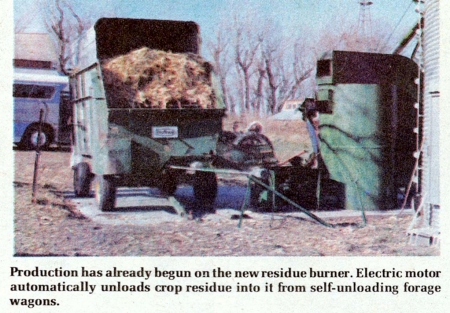
"Only 20% of the total crop residue is needed to dry the entire corn crop," says Eugene Sukup, president of Sukup Mfg., Sheffield, Iowa.
Last fall, biomass (husks and cobs) salvaged from one acre of corn yielding 150 bu. of grain per acre provided enough fuel to dry right at 300 bu. of corn with 10 points of moisture removed.
With this in mind, Sukup Mfg. has introduced the first complete "system" for using corn stalks, straw, husks and other crop residues as a fuel for drying grain.
Sukup manufactures in bin drying and stirring equipment, an automatic residue burner and stoker, and a just-introduced, combine-mounted blower for collecting husks and cobs. The biomass burning system they developed combines existing equipment with the new blower, stoker and burner.
Residue from the combine is blown into any standard self-unloading forage wagon. The wagon is pulled alongside the residue burner where it is slowly unloaded with a simple electric drive Sukup makes. Any other similar method of slow unloading can also be used. A single load of husks and cobs will fire the burner automatically for up to 12 hours, according to Sukup. Heat from the burner can be used in most any existing drying setup.
The Sukup residue burner feeds heat directly from the firebox to the grain with no contamination problems -- despite the fact that the products of combustion are blown directly into the grain.
"Temperature in the burner reaches 900 degrees F and is diluted with cold, fresh air at the bin to provide 130 to 160 degrees F drying air. The high burner temperature burns off most contaminants so the drying air is generally clean and no heat exchanger is needed. Drying capacity is rated at 300 bu. per hour. maximum," explains Sukup.
"We dried 15,000 bu. of corn with the system this past season. We had no contamination problems and there is very little ash left over in the burner. The ash removed from our entire harvest season filled just one wheelbarrow," he adds. Production has already begun on the new residue burner, and will begin this spring on the attachment for salvaging crop residue on-the-go. A different combine blower will be available for each model of combine. The blower is belt-driven. When not in use, two trap doors in the bottom allow residue to drop to the ground as usual.
